Summary of the Evaluation of the Coastal Restoration Fund
About the evaluation
The evaluation was conducted between September 2019 and March 2020 in accordance with the Treasury Board’s Policy on Results (2016) and requirements of the Financial Administration Act.
The scope of the evaluation covered 2017-18 to 2019-20 and used multiple lines of evidence, including interviews, data analysis, field observations, a recipient workshop and document/file review.
About the Program
The Coastal Restoration Fund (CRF) is a five-year program that was established in 2017-18 and is set to end in 2021-22. The CRF is a grants and contributions program, funded through the Oceans Protection Plan (OPP The program was implemented with $84 million in funding over five years for projects that help restore coastal aquatic habitats, with a focus on:
- Addressing the impacts of historical development;
- Mitigating the results of increased marine shipping;
- Contributing to the recovery of species that are considered threatened, endangered or at risk; and
- Building local capacity to restore and maintain coastal habitats.
Number and dollar value (millions) of funded CRF projects, by region
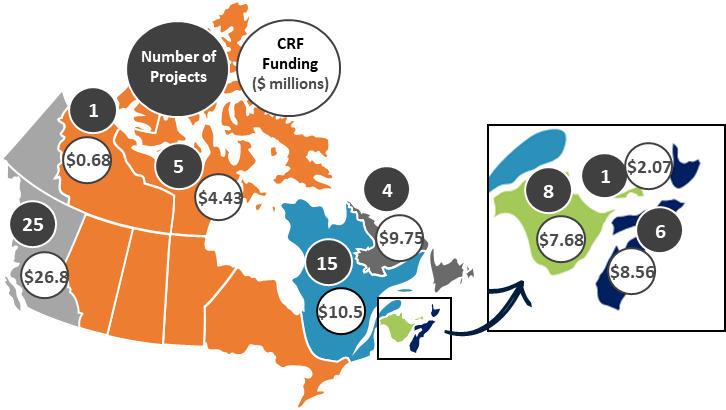
Description
A map of Canada showing the number and dollar value (in millions) of funded coastal restoration fund projects by region and province.
There are 25 projects in Pacific R egion all of which are in British Columbia, totalling $26.8 million. Within Central and Arctic Region, there is 1 project funded for $0.68 million, which is in Northwest Territories; and 5 projects funded for $4.43 million in Nunavut.
In the Quebec region, there are 15 projects funded for $10.5 million.
Gulf region encompasses New Brunswick and Prince Edward island, with 8 projects totalling $7.68 million and 1 project totalling $2.07 million, respectively.
The Maritimes region, which includes only Nova Scotia, has 6 projects totalling $8.56 million.
Finally, Newfoundland and Labrador Region has 4 projects totalling $9.75 million.
Key findings
Need for coastal restoration and national and regional priorities
The Coastal Restoration Fund responds to an identified need to address threats to aquatic ecosystems and marine biodiversity loss along Canada's coastlines. The program was designed using national priorities identified as part of the OPP and by working with stakeholders to identify regional priorities. The identified priorities were considered when assessing project proposals. As a result, the CRF has provided funding for large-scale, multi-year restoration projects that are aligned with national and regional priorities such as improving fish passage and restoring historical coastline modifications.
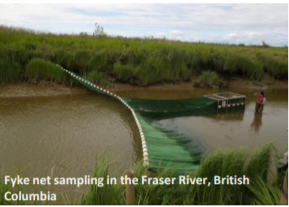
Description
A CRF project is working to re-connect habitat through dike breaches and improvements to water control structures. While it is early in the restoration process, juvenile Chinook salmon are already starting to move into the breached areas.
Impact of the Coastal Restoration Fund
Through eligible funding, CRF recipients were able to develop studies and strategic plans prior to undertaking projects, which allowed them to prioritize needs and determine appropriate measures to effectively restore the selected sites. Additionally, recipients are required to implement monitoring and maintenance of the restored sites. Both of these activities are viewed as important to understand the long-term benefits of the projects.
As the program is still in its implementation phase, it is too early to see the full impact of the CRF projects; however, there are indications that the funded projects are contributing to restoring coastal areas, including:
- Improving fish passage for migration through habitat restoration (e.g., restoring salt marshes);
- Mitigating human-imposed barriers (e.g., replacing impassable culverts); and
- Conducting studies on the landscape to determine restoration needs (e.g., environmental improvements and needs assessments).
CRF projects are also expected to have a positive impact on endangered and threatened species (e.g., increasing fish populations that serve as prey for the Southern Resident Killer Whales).
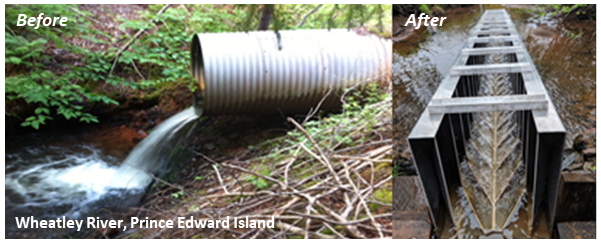
Description
The Prince Edward Island chapter of Trout Unlimited Canada is working to replace impassable culverts with bridges, box culverts, or fish passages. This work allows for free passage of many species to travel upstream to spawn in the freshwater systems.
Target groups, collaboration and networks
The CRF targeted large-scale projects suited for high capacity organizations. The program reached its intended target groups and is resulting in increased collaboration, as all funded recipients have partnered with at least one organization to implement their projects. Almost all funded projects include an Indigenous group in a variety of roles and in some cases, this involvement is leading to improved relationships with the Indigenous groups. In addition, the CRF program allocated salary and O&M funding to provide opportunities (e.g., training, workshops) for recipients and their partners to network and share expertise with each other.
Number CRF recipients and type of funded organization
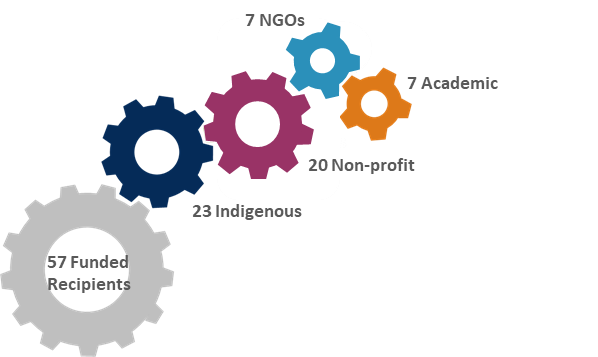
Description
A series of cogs shows the number of CFR recipients and the types of funded organizations. In the lower left, a large cog indicates the total number of CRF recipients is 57. Moving upwards and through increasingly smaller cogs, the next cog represents 23 Indigenous recipients, the next cog shows 20 non-profit organizations, the next cog shows 7 non-government organizations, and the last cog shows 7 academic groups.
As a result of the CRF, recipients and their partners are developing new skills and capacity, which are expected to go beyond the life of the individual projects.
Delivery of grants and contributions programming
Despite limited standardized tools and processes for the management of grants and contributions at the outset of the program, the CRF used good practices in the design of the program. Improvements were made throughout the implementation of the program (e.g., developing a checklist for year-end reporting).
One of the biggest challenges regarding the delivery of the CRF program is related to the lengthy year-end report review process, which is having an impact on the disbursement of funds to recipients. The CRF currently releases a 90% advance payment to recipients in their first year, with a 10% hold back of the remaining annual funding. The 10% holdback and the next 90% advance payment is released upon approval of a recipient year-end report for the first year.Footnote 1
As of January 2020, 59% of payments due in 2019-20 had not been disbursed for projects—a value of $8.3M. The delay is attributable to delays in approving year-end the reports that recipients are required to submit.
Funds not disbursed in 2019-20, compared to what was supposed to be disbursed (as of January 2020)
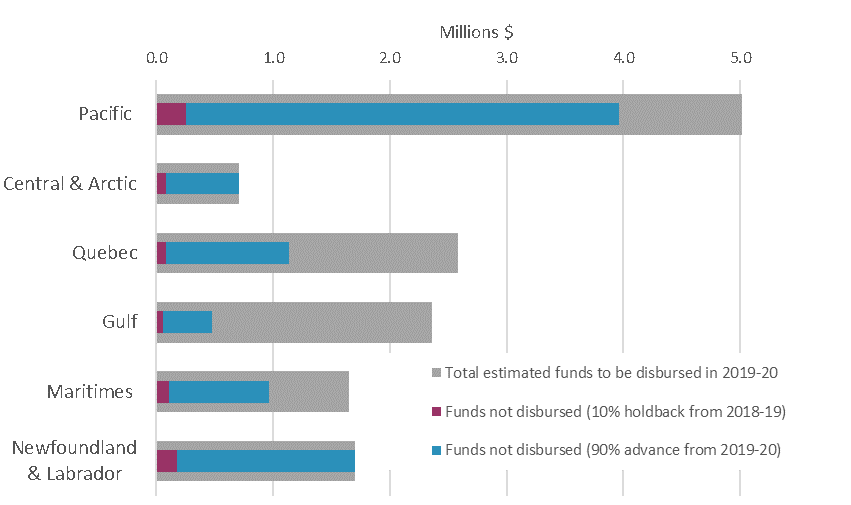
Description
This bar graph shows the total estimated CFR project funds to be disbursed in 2019-20, funds not disbursed (10% holdback from 2018-19), and funds not disbursed (90% advance from 2019-20).
The total estimated funds to be disbursed in 2019-20 for Pacific region was approximately $5 million; of this, approximately $4 million in funds were not disbursed.
The total estimated funds to be disbursed in 2019-20 for Central and Arctic region was approximately $0.7 million; none of the funds were disbursed.
The total estimated funds to be disbursed in 2019-20 for Quebec region was approximately $2.6 million; of this, approximately $1.1 million in funds were not disbursed.
The total estimated funds to be disbursed in 2019-20 for Gulf region was approximately $2.3 million; of this, approximately $0.5 million in funds were not disbursed.
The total estimated funds to be disbursed in 2019-20 for Maritimes region was approximately $1.6 million; of this, approximately $1 million in funds were not disbursed.
The total estimated funds to be disbursed in 2019-20 for Newfoundland and Labrador region was approximately $1.7 million; none of the funds were disbursed.A number of factors contributed to delays in approving the year-end reports, which had an impact on the disbursement of payments including: a lengthy year-end report review process, competing priorities within the department, a lack of service standards for the approval of the year-end reports, low risk tolerance, and low level of flexibility to move funds between fiscal years and funded activities.Footnote 2
Lessons learned
Need for coastal restoration and alignment with priorities
- Clearly identifying national and regional coastal restoration priorities during the design and early implementation phase of the Coastal Restoration Fund program ensured that funded projects aligned with identified priorities.
Impact of the Coastal Restoration Fund
- The funding of studies and planning, as part of Coastal Restoration Fund projects, enhanced the effectiveness and efficiency of projects by allowing recipients to prioritize needs and determine appropriate measures to restore sites and will help ensure their long-term sustainability.
- The requirement for monitoring and maintaining the long-term sustainability of projects, as part of the Coastal Restoration Fund, will increase the understanding of the long-term benefits of the funded projects.
Target groups, collaborations, and networks
- Networking and skills sharing events, both at the national and regional level, provided recipients and their partners with the opportunity to meet, share expertise, and learn about each other's projects.
Delivery of grants and contributions programming
- Given the increase in grants and contributions programs within DFO, it is important for the department to have standardized tools and guidance for the management of grants and contributions for program managers at the outset of the program, including ongoing training to ensure consistent application of the tools and guidance across the department.
- To ensure that there are no delays with the disbursement of funds, it is important to have service standards in place for key points in the process prior to program implementation.
- To support efficient program delivery it is important that the reporting process be designed to ensure compliance with the obligations of the funding agreement but also be reflective of the level of risk specific to the program.
- Date modified: